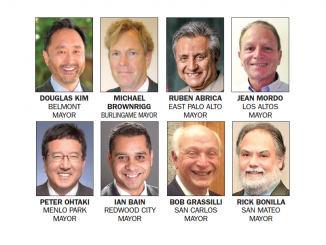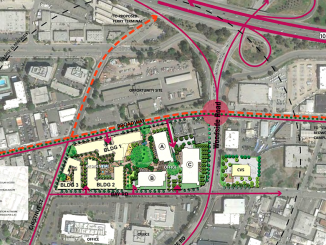
Above is an illustration of what the Roosevelt Avenue-El Camino Real intersection will look like when the El Camino plan is implemented. Illustration is from page 17 of the plan.
BY EMILY MIBACH
Daily Post Staff Writer
Redwood City Council last night (Dec. 4) approved a plan to eliminate parking along El Camino Real and the mayor reflected on the shortcomings of the city’s downtown plan to make sure the city isn’t stuck with ugly buildings.
“One of the mistakes is that we gave up too much control,” said Mayor Ian Bain regarding the city’s “downtown precise plan,” which was a zoning plan for the area approved in 2011.
The downtown plan set caps for development, but a boom of tall apartments and office buildings followed.
“We’ve gotten a few cookie-cutter buildings,” Bain said. “And some of the best buildings have come after significant pushback from council and residents.”
Vice Mayor Diane Howard and Bain said they would like to see the Architectural Advisory Committee be more empowered at the beginning of the planning process for new developments.
This could protect the city from getting stuck with buildings that don’t look like they belong in Redwood City, or a canyon effect along El Camino.
Howard said the city needs to be forceful in demanding better architecture.
With the approval of the El Camino Real Corridor plan, the council will talk about zoning guidelines for the area.
Currently the area is zoned to have office and retail on the ground floor and housing on the other floors.
The council will look at whether that ground-floor work space should still be a requirement.
The plan also included a proposal to take away street parking along El Camino and replace it with buffered bicycle lanes.
Howard said she wants to see a pilot program of the bike lanes before they become permanent. She said the city has learned from its “road diet” on Farm Hill Boulevard, where the council approved decreasing four car lanes to two and adding bike lanes, which snarled traffic.
Parking would be removed from Northumberland Street to the city’s border with San Carlos, according to the plan. Sidewalks would be expanded to 12- to 16-feet wide from their current 8 feet to allow businesses to install seating outside and for people to feel less cramped on the sidewalks.
Gita Dev, who spoke in support of the plan, said she is often worried that her husband, who uses a wheelchair, may tip over because the sidewalks are so narrow and slanted along El Camino Real. Others who spoke in favor of the project said the buffered bike lanes will make it safer for drivers, bicyclists and pedestrians.
Councilman John Seybert said the bike lanes may get traffic moving because drivers won’t be concerned about a bicyclist swerving in front of them.
But the bike lanes would replace the 266 parking spaces along El Camino.
The plan recommends that some retailers along El Camino with large and underused parking lots team up with businesses that would be losing their parking.
Councilman Jeff Gee also said this may spark the need for residential parking permits to protect neighborhoods off El Camino from spillover parking.



